Discover the untold stories of the Bible's harlots, whose tales of redemption and mystery challenge our views on faith and morality.

Harlots in the Bible
Did you know that the Bible mentions harlots more than 50 times?
You've probably encountered tales of Rahab, the prostitute who played a pivotal role in the fall of Jericho, or pondered the complex story of Mary Magdalene and her misconceptions.
These women, often viewed through a lens of morality or immorality, occupy significant narratives that challenge our understanding of faith, redemption, and divine purpose.
As you explore their stories, you'll uncover layers of cultural, historical, and spiritual significance that might change how you view these figures.
Let's peel back these layers together, and you might find yourself surprised at what lies beneath.
Key Takeaways
- Biblical narratives highlight the transformation and redemption of marginalized women through faith and decisive actions.
- Symbolic acts of repentance by such women challenge societal judgments and offer deep insights into forgiveness and redemption.
- These stories often showcase women employing unconventional methods, like deception, to assert their rights and dignity within patriarchal systems.
- The theme of unconditional love, especially in divine relationships, underscores the potential for redemption and change regardless of past actions.
Rahab: The Scarlet Savior
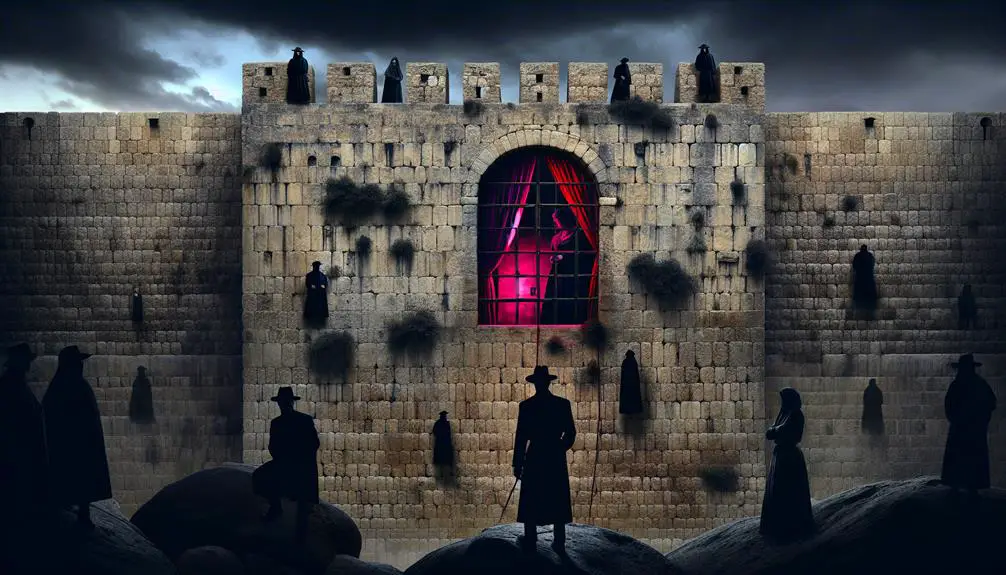
Among the myriad figures in the Bible, Rahab stands out as a pivotal character whose actions directly contributed to the success of the Israelite spies in Jericho. Her story isn't just a tale of espionage and intrigue but also one of profound faith's transformation. As a resident of Jericho, Rahab's initial position was as an outsider to the Israelite cause. Yet, her decision to shelter the spies and mislead her own people was a critical element in Jericho's strategy, showcasing a remarkable shift from a life marked by societal marginalization to becoming a key figure in Biblical history.
Rahab's actions can be analyzed through the lens of faith's transformation. Her belief in the God of Israel led her to risk everything, including her life and the lives of her family, to aid the spies. This wasn't just a calculated move for survival; it was a clear demonstration of her faith in a power beyond her city's walls. Rahab's story underscores the theme that faith can lead to redemption and change one's destiny, irrespective of past actions or social standing.
Moreover, her role in Jericho's strategy was pivotal. By hiding the spies and providing them with crucial information about the city's defenses, Rahab directly influenced the course of the battle. Her actions demonstrate that individuals often overlooked or marginalized can have a significant impact on historical events, challenging prevailing narratives about power and influence.
In essence, Rahab's story is a testament to the transformative power of faith and the significant role that individuals, often from the peripheries of society, can play in shaping history.
The Anointing Woman's Tears
You must consider the anointing woman's tears within the broader Biblical narrative and cultural backdrop to grasp their significance fully.
Analyzing the symbolic gesture interpretation offers insights into the socio-religious dynamics of the time.
Exploring the cultural context further illuminates how these actions were perceived and their impact on contemporary and subsequent audiences.
Symbolic Gesture Interpretation
The tears of the anointing woman in the biblical account symbolize a profound gesture of repentance and humility, reflecting deep-seated emotions and societal implications. This gesture's significance reaches beyond the surface, serving as a bridge between personal transformation and societal perception.
Interpretive challenges arise in fully understanding the depth of this act, as it encompasses a range of emotions and intentions that transcend words. Analyzing this gesture requires a nuanced approach, recognizing it as both a personal expression of sorrow and a societal critique. It's an emblematic act that challenges viewers to contemplate the complexities of repentance, societal judgment, and the power of non-verbal communication.
Understanding this gesture's layers offers insights into the broader themes of forgiveness, redemption, and the human condition.
Cultural Context Exploration
Exploring the cultural context of the anointing woman's tears sheds light on the intricate dynamics of repentance and forgiveness within her society. Your understanding of this scenario is incomplete without recognizing the societal norms and gender roles that framed her actions and the reactions she elicited.
- Societal norms often marginalized women, making public acts of repentance both a defiance and a submission.
- Gender roles dictated a woman's place, yet her tears challenged these conventions.
- Her weeping wasn't just personal sorrow but a profound critique of societal expectations.
- This moment underscored the transformative power of forgiveness in a rigidly structured society.
Analyzing her tears through the lens of societal norms and gender roles reveals the depth of her act, extending far beyond personal repentance to touch on broader themes of social acceptance and change.
Tamar's Veiled Deception
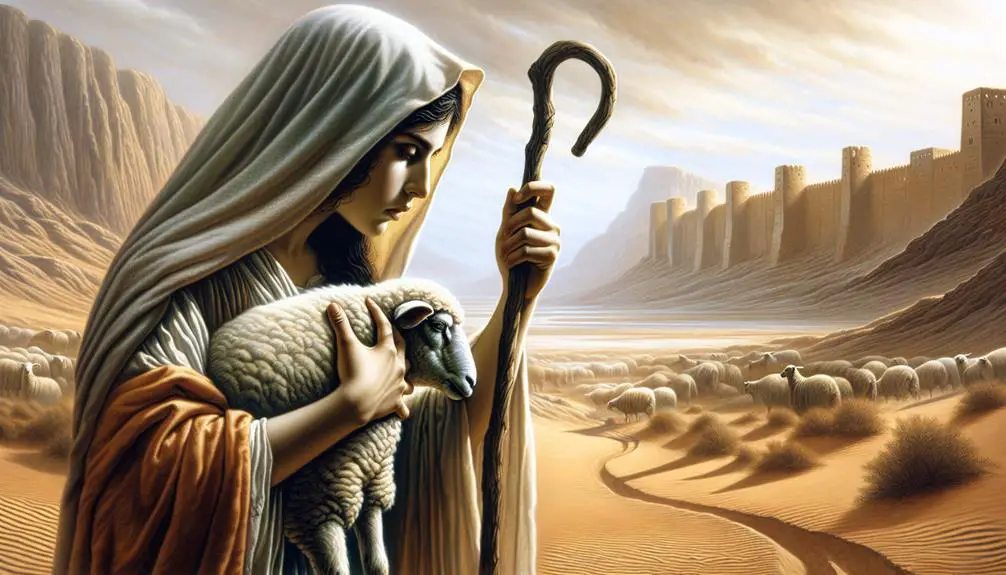
In the biblical account, Tamar's veiled deception represents a complex maneuver to secure her rights within a patriarchal society. She's cornered into taking drastic measures due to Judah's failure to uphold his duties towards her as a widow of his sons. This narrative doesn't just challenge Judah's accountability but also raises questions about the ethics of disguise.
Tamar's actions, while deceptive, underscore the lengths to which she must go to ensure her survival and uphold her rightful place within the lineage of Judah. Her disguise as a prostitute to seduce Judah, her father-in-law, might appear unethical at first glance. Yet, when viewed through the lens of her desperate circumstances and Judah's neglect, her strategy is recontextualized as a form of resistance against a system that leaves her with no other recourse.
The following table offers a concise overview of the key elements in Tamar's story:
Aspect |
Insight |
|---|---|
Judah's Failure |
Neglects his duty to provide Tamar with offspring. |
Tamar's Strategy |
Disguises herself to claim her rights directly from Judah. |
Disguise Ethics |
Raises questions about morality in desperate circumstances. |
Patriarchal Society |
Contextualizes Tamar's actions as a fight for survival. |
Outcome |
Tamar is vindicated; her actions lead to securing her lineage within Judah's family. |
Tamar's story is a profound examination of the lengths to which individuals may go to fight for their rights and dignity within constraining societal norms.
Gomer: Love Redeemed
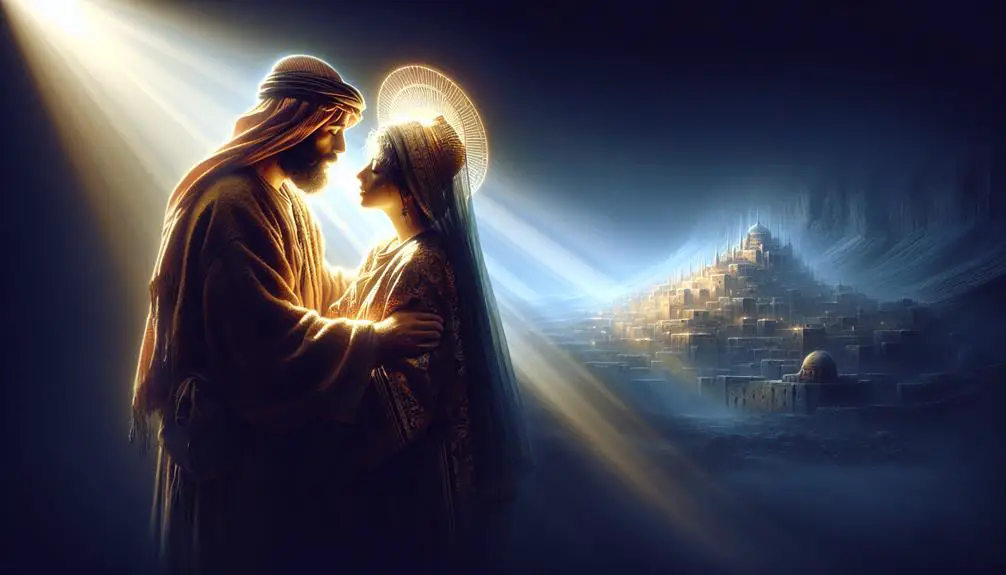
Shifting focus to Gomer's narrative, we encounter a tale of profound redemption and the complexities of unconditional love within a covenant relationship. Gomer's story, deeply embedded in the prophetic literature, exemplifies the struggle with marital fidelity and showcases the prophet's love as a metaphor for a broader divine relationship.
Gomer, married to the prophet Hosea, becomes emblematic of infidelity, not just in the marital sense but also as a symbol of the people's unfaithfulness to their covenant with God. The narrative unfolds to reveal not just the pain of betrayal but the power of love and forgiveness in the face of waywardness. Here, the prophet's love for Gomer serves as a poignant reflection of unconditional divine love.
- The prophet's relentless pursuit of Gomer, despite her unfaithfulness, evokes a deep emotional response, highlighting the lengths to which love will go to redeem and restore.
- Gomer's story is a vivid illustration of the complexity of human relationships, where love and loyalty are continually tested.
- The narrative invites readers to reflect on the nature of forgiveness, posing challenging questions about the limits of love and the possibility of redemption.
- Through Gomer's redemption, the story emphasizes the transformative power of love to overcome the deepest breaches of trust.
Analyzing Gomer's narrative provides a nuanced understanding of the themes of marital fidelity and the prophet's love, offering insights into the enduring human quest for redemption and the complexities of covenant relationships.
The Prostitute and Hosea
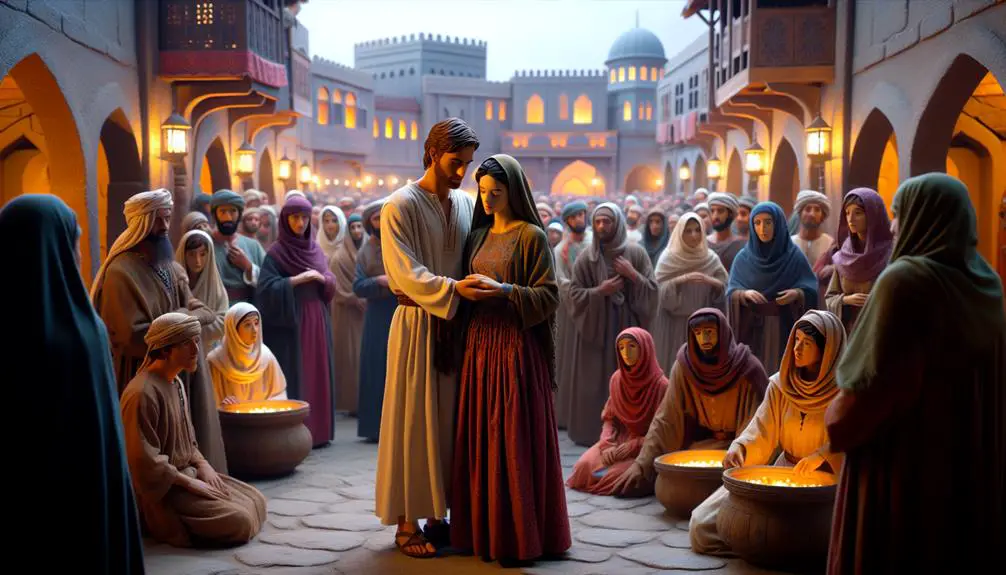
Delving into the narrative of Hosea and the prostitute, we encounter a profound exploration of loyalty, love, and the capacity for forgiveness. This story, deeply embedded within the Judeo-Christian tradition, serves as a complex symbol of marital fidelity and divine allegory. Hosea's marriage to a prostitute, as commanded by God, becomes a vivid illustration of the tumultuous relationship between the divine and the unfaithful people of Israel.
The text positions Hosea's actions not as mere personal or historical events but as a metaphor for a larger spiritual truth. The prophet's willingness to marry a woman known for her infidelity mirrors the unwavering commitment of the divine towards a wayward humanity. This narrative layer emphasizes the concept of unfailing love and forgiveness, despite repeated transgressions.
In this context, marital fidelity transcends its conventional boundaries and morphs into a reflection on divine patience and commitment. The prostitute in the story, while initially representing betrayal and moral failure, becomes a figure of redemption and grace. Through this lens, the narrative challenges readers to reconsider notions of love, loyalty, and redemption.
Analyzing the story as a divine allegory, one can't help but appreciate its depth. It suggests that the essence of divine love isn't contingent upon the fidelity of its recipients but is instead a constant, unyielding force. This allegory serves as a stark reminder of the potential for forgiveness and renewal in the face of betrayal, urging a reflection on the nature of divine and human relationships marked by flaws yet capable of redemption.
Mary Magdalene's Misconception
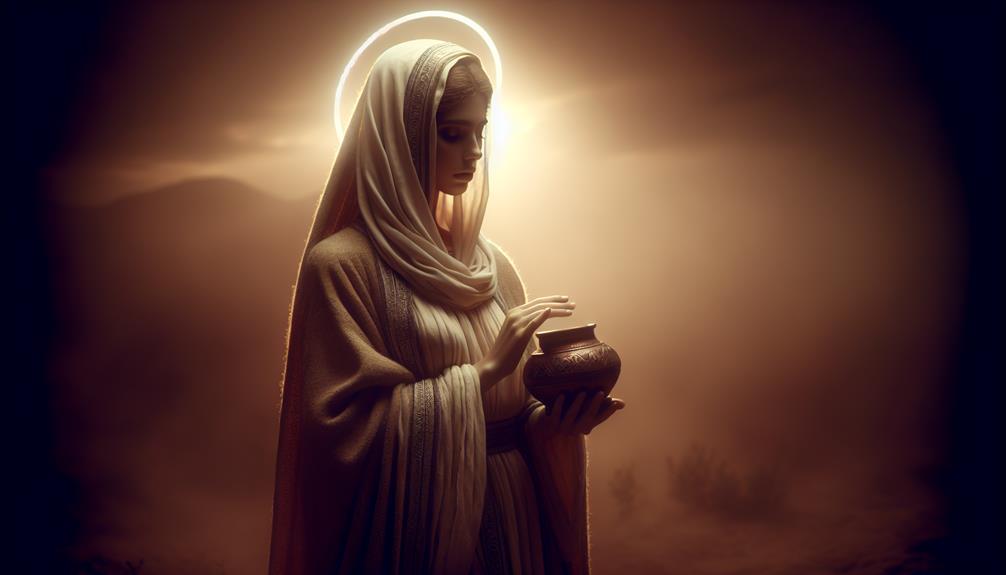
You may find it surprising that Mary Magdalene's common portrayal as a prostitute lacks biblical evidence.
Instead, her true role emerges from scripture as a devoted follower and witness to Jesus' resurrection.
This misconception underscores the need for careful examination of historical and scriptural contexts to understand her genuine significance.
Misidentified as a Prostitute
One pervasive misconception in historical and religious discourse involves Mary Magdalene, often erroneously identified as a prostitute. This misidentification stems not from historical accuracy but from societal stigmatization, where the conflation of her identity has led to significant misunderstanding and, more importantly, unwarranted judgment.
- *Historical inaccuracies have perpetuated the myth, distorting Mary Magdalene's true legacy.*
- *Societal stigmatization of women has contributed to this mischaracterization, reflecting broader issues of gender bias.*
- *The emotional toll on those who find personal identification with Mary Magdalene can be profound, feeling misrepresented.*
- *This misconception challenges the integrity of religious scholarship, demanding a reevaluation of how religious figures are portrayed.*
In essence, the narrative surrounding Mary Magdalene calls for a closer examination, urging us to question and rectify historical misconceptions.
True Biblical Role
Shifting focus to Mary Magdalene's true biblical role reveals a narrative far removed from that of a prostitute, highlighting her significant contributions as a devoted follower and witness to Jesus Christ's resurrection. Her story challenges deeply ingrained gender stereotypes and sheds light on the social marginalization faced by women in biblical narratives.
Aspect |
Description |
Impact on Perception |
|---|---|---|
Role |
Devoted follower and witness to the resurrection |
Elevates her significance |
Misconception |
Misidentified as a prostitute |
Reflects gender stereotypes |
Contribution |
Early Christian community supporter |
Challenges social marginalization |
Legacy |
Misunderstood figure reclaimed |
Encourages reevaluation |
The Samaritan Woman's Thirst

In the narrative of the Samaritan woman at the well, her thirst transcends the physical realm, symbolizing a deeper spiritual longing. As you delve into her story, it becomes evident that her encounter with Jesus at the well isn't merely about quenching a bodily need but addresses a profound quest for 'living water.' This term, introduced by Jesus, signifies a source of eternal life and fulfillment beyond the transient satisfaction of earthly desires. The conversation subtly unfolds the layers of social stigma she carries, being a Samaritan and a woman with a complex personal history, highlighting the transformative power of recognition and acceptance.
The woman's initial misunderstanding of 'living water' reflects humanity's frequent misinterpretation of spiritual sustenance as material satisfaction. Jesus' offer of living water serves as a metaphor for the spiritual awakening and redemption available to all, irrespective of their social or moral standing. The encounter challenges societal norms, as Jesus, a Jew, engages meaningfully with a Samaritan woman, breaking cultural barriers of the time. Her transformation from a socially marginalized individual to a messenger of hope for her community exemplifies the restorative power of spiritual enlightenment.
This narrative is a compelling exploration of the interplay between physical needs and spiritual yearning, offering a nuanced perspective on redemption and the universality of human desire for a deeper connection. It underscores the idea that true fulfillment transcends societal constructs, inviting a reflective consideration of one's own spiritual journey.
Jezebel: Power and Prophecy
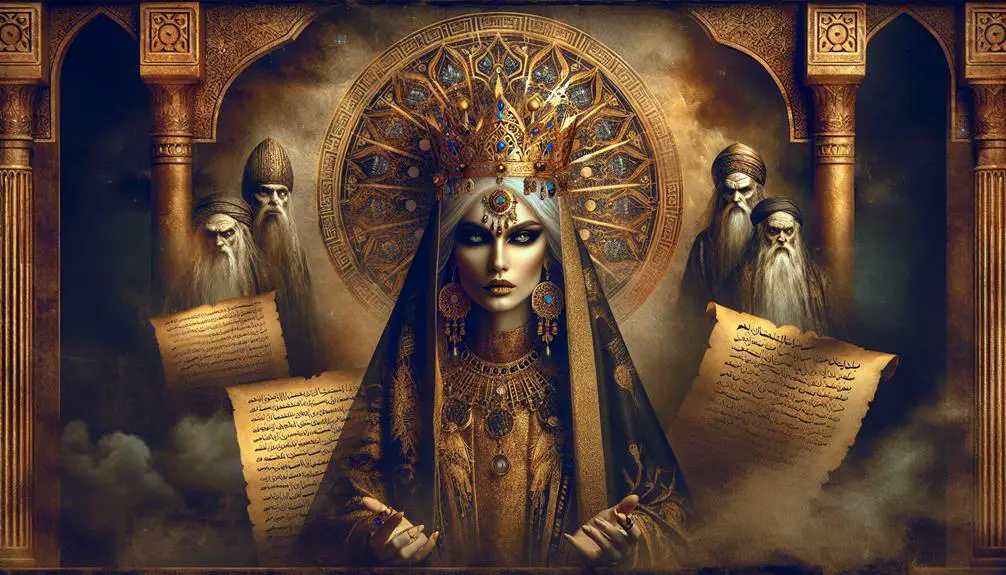
While the Samaritan woman's story highlights a quest for spiritual fulfillment, Jezebel's narrative introduces a compelling examination of the interplay between power and prophecy in the biblical context. Jezebel, a figure often vilified, emerges from a complex background that significantly shapes her actions and the perceptions of those around her. You'll find her story isn't just about personal decisions but is deeply entrenched in the dynamics of power, prophecy, and the political landscape of her time.
Jezebel's lineage, originating from the Sidonian royal family, positions her in a unique intersection of political power and religious practice. Her marriage to Ahab, king of Israel, isn't merely a personal union but a strategic alliance, bringing Ahab's influence to the forefront of her narrative. This alliance becomes a pivotal point in the story, influencing the religious and political climate of Israel.
Aspect |
Jezebel's Influence |
Ahab's Influence |
|---|---|---|
Religion |
Introduced Baal worship |
Facilitated its spread |
Politics |
Strengthened ties with Sidon |
Expanded royal authority |
Prophecy |
Opposed by Elijah |
Passive participant |
Legacy |
Seen as a villain |
Overshadowed by Jezebel's actions |
Jezebel's active promotion of Baal worship and her confrontation with the prophet Elijah underscore the tension between established religious beliefs and the influence of foreign practices. This narrative isn't just a tale of personal ambition but reflects broader themes of cultural assimilation, religious conflict, and the struggle for power.
As you delve deeper into Jezebel's story, you see a figure shaped by her environment, wielding power in a male-dominated society, and challenging the prophetic voices that opposed her. Her story invites you to reconsider the complexities of biblical characters and the multifaceted nature of their narratives.
Frequently Asked Questions
What Societal Roles Did Women, Particularly Those Considered 'Harlots', Play in the Economic and Social Structures of Biblical Times?
You're exploring the roles women played in the economic and social structures of ancient times, particularly focusing on those labeled as 'harlots'.
They were integral, influencing religious practices and marriage dynamics significantly.
Despite societal marginalization, their interactions provided insights into the complexities of gender roles and economic survival.
Their existence challenged and sometimes changed the established norms, shedding light on the broader societal attitudes towards women and sexuality in historical contexts.
How Have Interpretations and Perceptions of Biblical Harlots Changed With Modern Feminist Readings of the Texts?
How do modern feminist readings transform our understanding of historical narratives?
Through feminist hermeneutics, you'll find that perceptions of biblical women, once labeled as 'harlots,' have undergone a significant cultural reevaluation.
This approach not only challenges traditional interpretations but also highlights the complexities of their societal roles.
It's a deep dive into the texts that reveals the multifaceted characters beyond their labels, enriching our understanding of their stories and the cultures they navigated.
In What Ways Do Biblical Stories of Harlots Intersect With Contemporary Issues of Gender, Sexuality, and Marginalization?
You'll find that stories about harlots intersect with today's issues of gender, sexuality, and marginalization through themes of sexual autonomy and religious judgment.
These narratives challenge societal norms and invite a reevaluation of moral compasses. They spotlight the struggles for autonomy against a backdrop of moral and religious scrutiny, reflecting broader debates on sexual freedom and the ongoing fight against gender-based marginalization.
This analysis reveals the enduring relevance of these stories.
Can the Redemption Arcs of Biblical Harlots Be Seen as Early Examples of Narrative Complexity and Character Development in Ancient Literature?
Absolutely, the redemption arcs you're exploring can be seen as pioneering examples of narrative complexity and character development in ancient texts. These stories introduce literary archetypes and redemption symbolism that resonate deeply with readers.
They showcase early attempts at nuanced storytelling, where characters evolve and transform, challenging initial perceptions. This kind of character progression offers a rich field for scholarly analysis, highlighting the ancient roots of modern narrative techniques.
How Do the Stories of Biblical Harlots Challenge or Reinforce the Moral and Ethical Codes of Their Time, and What Implications Does This Have for Modern Readers?
When you peel back the layers of ancient narratives, you'll find stories that intricately challenge or bolster the moral fabric of their era. These tales, without specifying their origin, often explore the tension between divine punishment and cultural norms.
For you as a modern reader, they serve as a mirror, reflecting how societies navigate the complexities of ethical codes. They invite you to ponder the evolution of morality across ages, analyzing its roots in ancient texts.
Conclusion
In the tapestry of biblical narratives, women labeled as harlots emerge not merely as characters shrouded in infamy but as pivotal figures in the divine drama.
From Rahab's scarlet thread of salvation to Mary Magdalene's unwarranted stigma, their stories weave a complex fabric of redemption, love, and misunderstood identity.
These tales, far from being mere footnotes in scripture, shine as a constellation of grace, challenging perceptions and illuminating the profound truth that no one is beyond the reach of transformative love.



Sign up